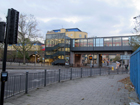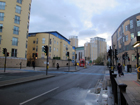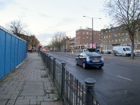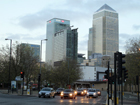www.italianialondra.it
Londra vissuta dagli Italiani ...
Westferry
Sintesi
Westferry è una stazione della Docklands Light Railway (DLR). Come leggerete nel "Toponimo", è una parte di Limehouse, quella che ospitava l'originaria "Chinatown", a cui abbiamo dedicato uno specifico paragrafo.
Distanza dal centro: 5,2 miglia.
Attrattiva: nulla.
Descrizione dell'area attorno alla stazione
Uscendo dalla stazione della DLR, siete in Limehouse Causeway in prossimità dell'incrocio con Westferry Road. Dall'alto, vedete il contesto circostante, che definire scadente è una benevolenza. Negli immediati dintorni, vedete costruzioni basse, ma l'orizzonte è "soffocato" da moderni grattacieli. Le cose non cambiano passando sotto al ponte. Trovate qualcosa che valga la pena andando verso nord-ovest, con lo spazio verde Ropemakers Field, Limehouse Cut, Limehouse Town Hall, St Anne's Church Limehouse e lo spazio verde Rectory Gardens (ma siete vicini alla stazione di Limehouse), verso sud-ovest, col Tamigi, verso sud-est, col Museum of London Docklands (più vicino alla stazione di West India Quay). I lati della stazione, ad est Pennyfields, ad ovest, Limehouse Causeway, rappresentarono l'originaria Chinatown di Londra.
Toponimo
La stazione di Westferry si trova nell'area di Limehouse e, per la sua prossimità all'ex stazione di Limehouse sulla "London & Blackwall Railway", avrebbe potuto mutuare tale nome. Tuttavia, fu la stazione di Stepney East ad venne ridenominata "Limehouse". In aggiunta, West India Quay venne utilizzato per la stazione all'altra estremità del West India Dock. Di conseguenza, non potendosi utilizzare le due logiche possibili denominazioni, occorse inventarne una nuova. Ma, se non esiste, né è mai esistito un sito denominato "Westferry", un "West Ferry", cioè, un traghetto (Ferry) verso ovest (West) è esistito, visto che le Ordnance Survey Maps del 1876 e del 1904 ne indicano uno che collegava Poplar a Rotherhithe. Vi era, un traghetto passeggeri sulla punta meridionale della Isle of Dogs gestito dai Barcaioli di Greenwich. Vi si accedeva da due strade, East Ferry Road, (nota localmenta anche come Farm Road) e Westferry Road, costruita nel 1812, quando, accanto al traghetto per passeggeri, venne introdotto un traghetto alimentato da cavalli (utilizzando generalmente un tapis roulant che serviva come motore). Le due strade esistono ancora oggi e scendono, rispettivamente, al centro e ad ovest dell'Isle of Dogs. Ma i loro nomi si riferiscono ad un antico servizio dalla stazione all'estremo finale dell'Isle of Dogs. Il nome, quindi, deriva, come visto, da "Westferry Road".
Storia
Utili informazioni sulla Storia dell'area si leggono in "Survey of London: Volumes 43 and 44, Poplar, Blackwall and Isle of Dogs" (1994), alle voci "Southern Millwall: The Byng Estate in Southern Millwall (pagine 452-462) e "Southern Millwall: The Barnfield Estate" (pagine 462-466). La Storia più recente si trova sempre in "Survey of London: Volumes 43 and 44, Poplar, Blackwall and Isle of Dogs" (1994), alla voce "Modern Docklands: The background to redevelopment" (pagine 686-691), che traduciamo e sintetizziamo liberamente.
1. Eventi storici di rilievo
West Ferry Road, insieme con la sua controparte orientale, venne realizzata quando i Proprietari terrieri e Imprenditori locali fondarono la "Poplar and Greenwich Ferry Roads Company" per costruire strade a pedaggio per il traghetto di Greenwich nel 1812. Ciò scandì l'apertura della parte interna della Isle of Dogs, sebbene la Penisola venne totalmente colonizzata solo dopo diversi decenni. La Società abbandonò il suo servizio di traghetti azionati da cavalli nel 1844, ma continuò a riscuotere pedaggi fino a quando il Consiglio Metropolitano dei Lavori (pubblici) la rilevò dai Proprietari ed eliminò, nel 1885, le porte dei caselli. Westferry Road venne gradualmente estesa e deviata, sino ad intersecare West India Dock Road nel 1960, quando il Consiglio della Contea di Londra demolì la "Rosher Estate". Proprio su tale incrocio insiste la stazione di Westferry, inaugurata nel 1987, come una delle originarie quindici fermate della Docklands Railway. L'area in prossimità della stazione, che un tempo, rappresentava il cuore dell'Est End Cinese, non venne per lungo tempo riqualificata, sino a quando i grattacieli della vicina Canary Wharf iniziarono a sovrastarla. Oggi, comunque, ancora vi sono zone critiche, come Trinitad Street, mentre, altrove, nuovi edifici civili e per uffici affiancano le case popolari costruite dopo la fine del Secondo Conflitto Mondiale.
2. La prima Chinatown di Londra
Fu esattamente a Pennyfields, immediatamente ad est della stazione, che si formò la prima Chinatown di Londra. Nel XVIII secolo, qui viveva una popolazione di Marinai cinesi che avevano lasciato le barche. Attorno al Porto di Londra proliferavano le attività illegali. I lettori dei libri su Sherlock Holmes sanno che Limehouse (che si estendeva sino a qui) era ritenuta un'area piena di fumerie d'oppio Cinesi, anche se è probabile che la criminalità tra i Cinesi fosse inferiore a quella dei vicini quartieri Inglesi. La costruzione di St. Katharine's Dock e di altri bacini chiusi fu dovuta principalmente alla necessità di eliminare le rilevanti perdite dovute ai furti mentre le merci venivano scaricate lungo la metà del Tamigi. In Epoca Vittoriana la reputazione dell'area accoppiava alle citate fumerie d'oppio, le case da gioco d'azzardo illegali. All'inizio del XX secolo, la popolazione Cinese di Londra era ancora concentrata in questa zona, la quale era dedita a creare imprese che servivano i Marinai Cinesi che frequentavano i Docklands. La zona divenne famosa per racconti esagerati proprio sulle fumerie di oppio (allora legali) e per le catapecchie. Tra la Prima e la Seconda Guerra Mondiale, due eventi determinarono l'abbandono dell'area da parte dei Cinesi: 1. A causa della grande disoccupazione del 1919, i Cinesi patirono la xenofobia e formarono oggetti di assalti, essendo accusati di stare dietro alla "tratta delgi schiavi bianchi; 2. Gran parte dell'area venne gravemente danneggiata dai bombardamenti aerei tedeschi durante la Seconda Guerra Mondiale, anche se un certo numero di anziani Cinesi continuava a viveva in questa zona. Tuttavia, dopo la Seconda Guerra Mondiale, la crescente popolarità della cucina Cinese e l'arrivo di Immigrati provenienti da Hong Kong, determinò l'apertura di un crescente numero di ristoranti cinesi altrove, tanto da far sorgere la nuova Chinatown nella City of Westminster, esattamente lungo Shaftesbury Avenue. Ad ogni modo, la presenza Cinese in quest'area viene ricordata da una scultura, "Dragon's Gate", che si deve all'Artista Peter Dunn (1997), ubicata all'intersezione tra Mandarin Street ed East India Dock Road. La presenza Cinese è anche attestata dalla "Chun Yee Society School", al numero 50 di East India Dock Road, all'angolo con Birchfield Street, dove si tiene una Scuola cinese e un circolo per anziani Cinesi. La strada di fronte è chiamata Canton Street, mentre Pekin Street e Nankin Street corrono parallele ad essa. Abbiamo la possibilità di "vedere" come era Chinatown al principio del XX secolo. Gli "occhi" sono quelli di George R. Sims, che ne racconta in "Limehouse and the Isle of Dogs - Chapter XI di 'Off the track in London', pubblicato da Jarrold & Sons (1911) ed ancora prima, nella rivista "The Strand" (luglio 1905): ".... The bus terminus - the West India Dock Station - is an excellent point from which to take a trip around Limehouse. Close at hand is the Causeway, the Chinese quarter. Now that a considerable portion of it has been pulled down, the Chinese element is not so prominent as it used to be. A goodly number of the sons of the Flowery Land have removed to the neighbourhood of High Street, Poplar; but in Limehouse the Asiatic seafaring men is still a conspicuous note. You will find specimens of him - Oriental, mysterious, romantic - at almost every turn. At the corner of the Causeway, as we turn into it in search of 'China Town in London,' we come upon a group of Lascars in their picturesque little round caps chatting together. Through the dock gates close at hand we see the Jap, the Chinaman, the Malay, and the negro pass side by side with the Scandinavian and the Russian. In and about Limehouse we should have little difficulty in finding the Persian, the Arab, the Egyptian, or even the South Sea Islander. But first let us make our way through narrow, winding China Town. There is no mistake about the Chinese element. The Chinese names are up over the doors of the little shops, and as we peer inside them we see the unmistakable Celestial behind the counter and Chinese inscriptions on the walls. At the back of one little shop is an opium den. If we enter we shall find only a couple of clients, for this is not the hour. The 'den' is dark and dirty and reeks unpleasantly. There are no Oriental garments or pigtails in this or in any other part of China Town. The Chinamen who have settled here in business have mostly married English wives, and have English babies who are wheeled out in English perambulators. The Chinese lodgers in the Chinese boarding-houses round about are seafaring men, and dress in serge suits and wear cloth caps under which the pigtail, if it has not been sacrificed, is coiled up and concealed. A pigtail would have a bad time in the hands of the local larrikin. Here is a Chinese grocery store. Some of the canned goods are familiar to European eyes, but all are labelled in Chinese characters. There are also mysterious compounds in glass bottles which may be drugs or dainties, something to eat or something to drink. The closest scrutiny fails to enable either my colleague or myself to arrive at a conclusion. We go into the shop and some young Chinamen come forward from a back parlour, gaze at us, and summon the proprietor. The proprietor is understood to speak English. He speaks it, and in despair I try a few words of Pidgin English which I remember to have read in a book of Charles Leland's. I say 'top side galaw,' 'belongy,' 'ketchee,' and 'chop,' and 'chow.' But Mr. Ching Kung only smiles at my Chinese and tries some more of his own English. Eventually I buy a long paper packet, scrawled all over with Chinese characters in gold on a pink and green ground, and I pay three-and-sixpence for it. I think I have purchased something absolutely Chinese to present to my domestic circle, and I carry it under my arm during the whole of our wanderings about Limehouse. When I get it home and open it amid the eager expectation of the aforesaid domestic circle, I discover that I have spent three-and-sixpence in 'crackers ' - the familiar firework that little English boys let off in the streets on the fifth of November and other festive occasions. A little way down from the Chinese grocer's is a typical Chinese boarding-house. In a big, square window there is a stuffed 'sea parrot,' with a weird Oriental arrangement of shells and seaweed and dried fish. Several young Chinese sailors are standing in the doorway. One has just returned with something in a mug. It may be beer. Suddenly the whirr of a gramophone is heard from the interior. 'A Chinese gramophone!' exclaims my colleague; 'we shall hear something.' The record begins to make itself heard, and out over China Town float the familiar strains of 'Bluebell.' Two or three English girls and a couple of children attracted by the gramophone gather about the doorway. One of the big girls has a sparring match with a Chinese youth. For the rest, though it is Saturday afternoon, the streets of China Town are silent as the grave. With the exception of the little group outside the lodging-house and ourselves, there is no one in sight but a Custom-house official, who in gold-laced jacket and peaked cap passes leisurely along. At the end of the Causeway are a few two-storey houses built into railway arches. The trains run over the top-floor ceiling. Outside they are peaceful-looking dwellings. How much peace there can be on the top floor when an express or a heavy goods train passes over them one can only conjecture. Leaving these quaint specimens of architecture on the right, we wander in and out of a network of narrow by-ways and quaint old-world thoroughfares to find ourselves presently in Three Colt Street. We have left Oriental Limehouse behind us. Here the environment is typical of the old-fashioned Cockney district with a strong leaven of the Irish element. Here are plenty of public-houses well filled, and here are the local gentlemen who loll against the wall and the local ladies who gossip at street corners, basket or bag on arm and latchkey on forefinger.".
3. Museum of London Docklands
Oltre alla Chiesa di St. Anne, che trattiamo in Limehouse, è l'altra attrattiva dell'area, anche se è comunque più vicina, anche se di poco, alla stazione di West India Quay, essendo raggiungibile anche da quella di Poplar. Vi sono Gallerie permanenti, mostre, interessanti corsi a pagamento. L'ingresso è gratuito.

Il ponte della DLR su cui insiste la stazione

Gli edifici che vedete dall'alto della stazione

Edifici bassi

I grattacieli che dominano l'orizzonte